
GH2 Digital Sharpening removable with hack?
-
Good test, gl.
Question: When you cover the contacts, can you still manually focus the Panasonic lens?
Also, what exactly did you use to cover the contacts? -
The real issue is that this ugly sharpening completely destroys the gentleness of the highlight roll off. Everything appears digital and videoish and the strobe effect is more evident.
I'm making a music video for an italian artist, i used many manual lenses and a panny.
Well i'm finding huge difficulties to give to these footages the right look. -
Thanks guys. Maybe V. will find a way to defeat/reduce it.
@Elenion, yep digital sharpening is really just increasing the contrast around edges. In fact sharpness in general = contrast. For example if light is bleeding into adjacent sensor pixels, then the darks become lighter = blurrier = less contrast. -
@_gl That settles that for me. Big-ups to you on this test.
-
Here it is.
It seems also to add a bit of contrast. This makes my panny lenses not useful to shoot video. I hate it. -
Here's my take: distortion correction softens, so Panny sharpens (and obviously doesn't shout about it, correction is controversial and they want us to think it doesn't degrade the image).
However the sharpening was tuned for the stock bitrates, which were blurrier - it just doesn't look good with hacked rates anymore. It depends on the shot, but see my real-world screengrabs on Page 1 of this thread. -
I was right, the sharpening (or at least some) is happening during distortion correction. That explains why AF lenses look sharper than manual lenses, and often _too_ sharp:
All pics shot on the Panny 20mm, Chris' 44mb(AQ4) | F1.7, 1/60, ISO 320 | Con -2, Sharp -2, Sat -1, NR -2
1) 24H normal (ie. with distortion correction)
2) 24H with contacts covered (no distortion correction)
3) 60i
4) shows an animated blowup of each shot (in a different order).
The distortion correction clearly applies sharpening - but it's more pronounced on already high-contrast areas (it's either intelligent, or threshold based in some way). That's why it's not obvious on all shots.
The 60i version is interesting: first it does seem to apply some vertical filtering - notice how the image is slightly stretched vertically (in the old interlaced CRT days this was done to eliminate flickering - for example NLE fonts were deliberately blurry back then to avoid it -but I don't understand why that would be necessary now). It looks like it's then even more heavily sharpened to compensate (check the blowup).
Also interesting are the interlace-type artifacts on colours, particularly noticable on the red areas (EDIT: ignore, this may be due to Premiere not upsampling the chroma channels of each field before weaving them).
(I've also attached the chart I used, I posted this some time ago but I don't think anybody used it).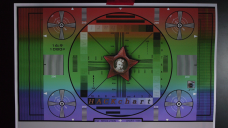
 24H.png1920 x 1080 - 3M
24H.png1920 x 1080 - 3M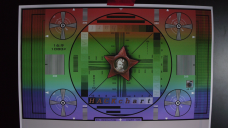
 24 Contacts Covered.png1920 x 1080 - 2M
24 Contacts Covered.png1920 x 1080 - 2M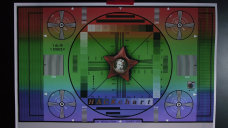
 60i.png1920 x 1080 - 3M
60i.png1920 x 1080 - 3M
 comparison.gif1011 x 698 - 1M
comparison.gif1011 x 698 - 1M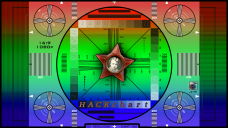
 HACKchart.png1920 x 1080 - 493K
HACKchart.png1920 x 1080 - 493K -
@stonebat I don't have an over-sharpening theory, just that taping the contacts should provide enough evidence of the presence/absence of in-camera sharpening for M4/3 lenses.
-
@Ptchaw Yeap the distortion correction occurs for sure. But I didn't see any noticeable sharpening. Can you prove your oversharpening theory?
-
I recently conducted a series of color comparison shots between the GH2, GH1, and Nikon D5100. Using the GH2 as the standard, I settled on the following Film Mode for both GH2 and GH1, with the right amount of sharpening for my tastes:
Smooth
Contrast -2
Sharpness -2
Saturation -1
Noise Reduce -2
To match the GH1 to the GH2, I adjusted GH1 White Balance to -R5. Further details here:
http://www.personal-view.com./talks/discussion/1195/nikon-d5100-compared-to-panasonic-gh2 -
@stonebat
Also it seems that Picasa cannot read GH2 rw2 correctly (hence the weird color and bars on the right side).
But yeah, lots of correction happening. -
@stonebat @LPowell Definative way to prove this is to take a picture with a M43 lens, then remove it (whilst the camera is still on to preserve the focus), tape over the contacts and replace it, fooling the camera into thinking it is a legacy lens. I tried it a while ago and remember the distortion correction was very noticable.
-
GH2VK, Lumix 14mm 2.5, Standard film mode 0,-2, 0, -2. 16:9 aspect ratio. I took a photo with both JPEG and RAW enabled.
1st photo: JPEG straight out of GH2. This one has in-camera distortion correction.
2nd photo: RAW -> Picasa 3.8 -> Export to JPEG without any other modification. It looks wider and shows the distortion. I guess the "0" contrast and "0" saturation settings of the film mode didn't apply to the RAW.
3rd photo: Set both at black and white and did comparison. This is top right corner of the photos. 1st photo on the left.
The in-camera JPEG has less detail and less noise. I wouldn't worry about the -2 sharpness setting. But the -2 noise reduction doesn't seem like doing a good job. Or maybe that's just in-camera JPEG lossy conversion's limitation. But I wouldn't worry about it because @driftwood's high bitrate settings produce more fine noise.
The theory that the camera body applies more sharpness after distortion correction didn't seem right. I'm inclined to @LPowell's theory that images from Panasonic m43 lenses look sharper because of the design of m43 lenses.
 20111015-P1040323.JPG4976 x 2800 - 8M
20111015-P1040323.JPG4976 x 2800 - 8M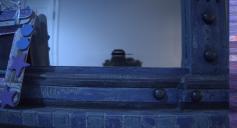
 20111015-P1040325.jpg5208 x 2816 - 2M
20111015-P1040325.jpg5208 x 2816 - 2M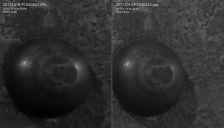
 Screen shot 2011-10-15 at 6.46.19 PM.png1638 x 938 - 392K
Screen shot 2011-10-15 at 6.46.19 PM.png1638 x 938 - 392K -
Further to Iresolution. I went back to the camera and realised it was on standard. I switched it off entirely, which is a pain in movie mode as it's greyed out and you have to access it in a stills picture mode. I switched it to OFF, Standard, and High and can totally see the difference between Off and the other modes. Not so much between Standard and High. The difference is enough for me to switch it off entirely in movie mode though. So thanks for the tip guys. Only major problem is very thin lines still are resolved in a wavy way which I had back in the GH1 days. This ultrafine detail is a moire artefact and I think the only way to deaden it is by using filters etc like promist.
-
I certainly agree there's something going on when using panny lenses. I'm not sure if it's a function along with the distortion correction, but non panasonic lenses that do not work with the electronic correction look reasonable to me.
-
The sharpening effect is the main reason I kept my GH1. On some scenes I just hated the sharpening (grass, leaves) However, I did a lot of my initial testing with the Panasonic 20mm. Thanks for the tip about the effect being different with MF lenses. I will retest some of the videos with some sharp primes. However, if the sharpening could be one notch lower in software that would be a cool feature. I'll also retest some of my noise videos as per Ian's suggestion, but I haven't noticed a big difference in noise since I use my Nikkor primes indoors and still get more noise with the GH2. But I'll retest against the Panny lenses.
-
>Do anyone knows the status of work of cbrandin for the film modes?
Work is going on.
Cris and I tried to change few curves found inside firmware.
Right now solution is not found. -
I'm just glad more people are starting to realize the connection. In addition I've also been attributing some (not all) of the extra noise we see in GH-2 images to the Panny lenses. But regardless the noise in the images is (mostly) pleasing.
-
Do anyone knows the status of work of cbrandin for the film modes?
-
I can very much confirm the extra sharpness on my Lumix lenses. Even with all sharpening off I do get edge sharpness artefacts. My Voigtlander gives the most pleasing image as it doesn't do this. I have the 7-14mm and have noticed it. You can see it if you pan across trees as a weird strobing and on contrasty edges like car details. It's a rather annoying thing to be honest. It can be slightly offset or softened by using my LCW Fader ND. This was notorious for softening but at least with the Panny lenses this is a bonus. I'd love a way to disable it. Of course my FD lenses produce nice results, none of this sharpening.
-
(for some reason I can't sign in via Firefox anymore, anyone know how to fix that?)
@LPowell,
> I think we agree on the value of lowering the '-2' sharpening limit in the film modes. Perhaps -4, -3, -2, -1, 0 would be a good range instead of the stock -2, -1, 0, 1, 2.
Yep I'd be very happy with that.
When I get time I'll run some proper tests on this, including the interlaced modes (with charts) and covering AF lens contacts. Unless someone beats me to it : ).
Has there been any news on the film mode hacking? If not I wonder if V @ cbrandin have already cracked it and want to suprise us with it on the next PTool release. -
@_gl
The GH2 image sensor is always scanned progressively, in interlaced video modes as well. The interlacing must be done in a later step that no doubt applies additional filtering to convert the frames into a 50i or 60i stream. It's hard for me to evaluate, as interlacing looks like crap to my eyes, regardless of whether it's soft or sharp.
I think we agree on the value of lowering the '-2' sharpening limit in the film modes. Perhaps -4, -3, -2, -1, 0 would be a good range instead of the stock -2, -1, 0, 1, 2. -
@LPowell, you may be right, but that's not the issue here. The sharpening on the GH2 is way beyond de-mosaicing (unless the sharpness is actually a demosaic parameter, in which case it can be dialed back). Look at interlaced video output, much softer - sharpening (wherever it happens) is obviously disabled there, or dialed way back. So it can be done.
There's a good chance that Vitaliy can just find & remove the '-2' limit from the film modes and give us more options. -
@_gl - "Look at RAWs in eg. SilkyPix with sharpening disabled - they're much softer than what's coming out of video."
Agreed, but this ties into my point as well. RAW image processing apps like SilkyPix and Adobe Color Raw use their own internal demosaic algorithms to convert RAW RGBG data into RGB pixels. Similarly to the GH2, these apps provide controls that allow you to adjust the amount of image sharpening used in the demosaic algorithm. When you set sharpness to minimum with these apps, they will actually suppress genuine image details present in high-contrast edges. While this may well produce an image quality that you prefer, it is technically due to uncompensated low-pass filtering rather than turning an extraneous sharpening filter "off".
Start New Topic


Howdy, Stranger!
It looks like you're new here. If you want to get involved, click one of these buttons!
Categories
- Topics List23,993
- Blog5,725
- General and News1,354
- Hacks and Patches1,153
- ↳ Top Settings33
- ↳ Beginners256
- ↳ Archives402
- ↳ Hacks News and Development56
- Cameras2,368
- ↳ Panasonic995
- ↳ Canon118
- ↳ Sony156
- ↳ Nikon96
- ↳ Pentax and Samsung70
- ↳ Olympus and Fujifilm102
- ↳ Compacts and Camcorders300
- ↳ Smartphones for video97
- ↳ Pro Video Cameras191
- ↳ BlackMagic and other raw cameras116
- Skill1,960
- ↳ Business and distribution66
- ↳ Preparation, scripts and legal38
- ↳ Art149
- ↳ Import, Convert, Exporting291
- ↳ Editors191
- ↳ Effects and stunts115
- ↳ Color grading197
- ↳ Sound and Music280
- ↳ Lighting96
- ↳ Software and storage tips266
- Gear5,420
- ↳ Filters, Adapters, Matte boxes344
- ↳ Lenses1,582
- ↳ Follow focus and gears93
- ↳ Sound499
- ↳ Lighting gear314
- ↳ Camera movement230
- ↳ Gimbals and copters302
- ↳ Rigs and related stuff273
- ↳ Power solutions83
- ↳ Monitors and viewfinders340
- ↳ Tripods and fluid heads139
- ↳ Storage286
- ↳ Computers and studio gear560
- ↳ VR and 3D248
- Showcase1,859
- Marketplace2,834
- Offtopic1,320
Tags in Topic
- hack 405
- sharp 7
- sharpening 2
- aliasing 2










